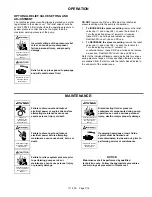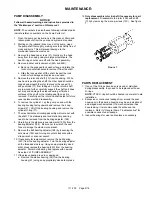
111-F00 Page 13/16
GENERAL PUMP TROUBLESHOOTING
NOTICE:
Maintenance shall be performed by qualified technicians only.
Follow the appropriate procedures and warnings as presented in this manual.
LEAKAGE
Location
Probable Cause/Corrective Action
Between the head & casing
Damaged head O-ring: Inspect and replace if necessary.
Burrs/dirt in head O-ring groove or cylinder: File and clean as
necessary.
Around the shaft
New Mechanical Seals: New seals may leak slightly at start up, but
should seal up shortly thereafter.
Damaged mechanical seals: Check for damaged O-rings or cracked,
scratched or worn seal faces
SHAFT BINDING
Probable Cause
Corrective Action
Burrs, dirt or foreign particles on the heads or discs.
During assembly, both heads and discs must be clean and smooth. File
any burrs or rough spots, and wipe the discs with a clean cloth and
alcohol to remove any dirt or foreign particles.
Improper bearing adjustment.
Bearings must be adjusted properly to center the rotor and shaft
between the head & bearing housing. Refer to the "Pump assembly "
section of this manual.
Contaminated mechanical seal faces.
Any trace of grease or dirt on the seal faces will prevent the faces from
mating properly, causing the rotor and shaft to bind or turn hard. Use a
tissue paper & alcohol to clean the seal faces. NOTE: Apply a light oil
or suitable lubricant to bronze seal faces only.
OTHER POSSIBLE CAUSES OF SHAFT BINDING:
• Foreign particles on rotor, liner or vanes.
• Damaged vanes or rotor.
• Bent push rods.
• Liquids that "set up" when inactive.
OVERHEATING
Probable Cause
Corrective Action
Pump is in bypass (internal or external) mode too long or
the bypass loop is too short
Adjust the bypass valve and/or internal relief valve so that the pump
does not operate in bypass mode so long.
Route the external bypass line back to the supply tank.
OTHER POSSIBLE CAUSES OF OVERHEATING:
• Improper system bypass valve adjustment
• Plugged discharge line.
• Closed valve.
LOW DELIVERY RATE
Probable Cause
Corrective Action
Bypass valve setting too low, causing the liquid to
bypass.
The Bypass valve setting should be 20 psi (1.4 bar) higher than the
differential pressure.
OTHER POSSIBLE CAUSES OF A LOW DELIVERY
RATE:
•
Restriction in the suction line.
•
Resistance in the discharge line.
•
Air leaks in the suction line.
•
Damaged or worn pump parts.
•
Pump speed too low or too high.
•
Bypass valve leaking.
•
Bypass valve sticking open, or not properly seating.
•
Dirty
strainer.
•
Liner installed backwards
•
Pump running in reverse
Summary of Contents for 111-F01
Page 15: ...111 F00 Page 15 16 NOTES...


































